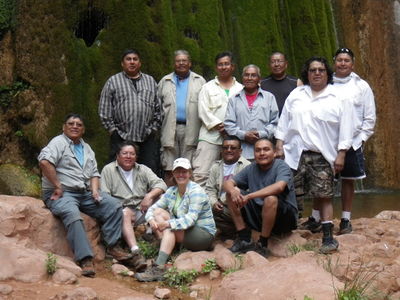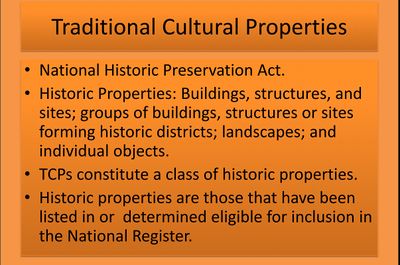Difference between revisions of "Tribal Resources"
Cellsworth (Talk | contribs) |
Cellsworth (Talk | contribs) |
||
| Line 38: | Line 38: | ||
• Attributes are maintained such as National Register eligibility is not compromised. These attributes will be specific to the traditionally associated peoples and will need to be identified by the federal agencies in consultation with those groups. Attributes may include aspects of location or physical integrity, as well as be intangible elements that link the resource to ongoing traditional cultural practices.<br> | • Attributes are maintained such as National Register eligibility is not compromised. These attributes will be specific to the traditionally associated peoples and will need to be identified by the federal agencies in consultation with those groups. Attributes may include aspects of location or physical integrity, as well as be intangible elements that link the resource to ongoing traditional cultural practices.<br> | ||
• The ability of traditionally associated people to maintain access to and use of the resources is preserved, in accordance with applicable law.<br> | • The ability of traditionally associated people to maintain access to and use of the resources is preserved, in accordance with applicable law.<br> | ||
| − | Culturally appropriate conditions of resources are maintained based on traditional ecological knowledge; integration of the desired condition is included in relevant monitoring and management programs.<br> | + | • Culturally appropriate conditions of resources are maintained based on traditional ecological knowledge; integration of the desired condition is included in relevant monitoring and management programs.<br> |
• Maintain ongoing consultation with the groups for whom the resource has traditional value. Because the desired condition of a TCP needs to be determined by the group for whom it has the traditional value, ongoing consultation is necessary to assess the condition of the resource.<br> | • Maintain ongoing consultation with the groups for whom the resource has traditional value. Because the desired condition of a TCP needs to be determined by the group for whom it has the traditional value, ongoing consultation is necessary to assess the condition of the resource.<br> | ||
• Mitigate impacts that affect the integrity of the TCPs. How and if effects can be mitigated will need to be developed in conjunction with the traditionally associated peoples for whom the resource holds value.<br> | • Mitigate impacts that affect the integrity of the TCPs. How and if effects can be mitigated will need to be developed in conjunction with the traditionally associated peoples for whom the resource holds value.<br> | ||
Revision as of 21:13, 2 May 2017
|
|
Tribal ResourcesThe lower reaches of Glen Canyon and the river corridor through Grand Canyon National Park, Arizona, have been used by humans for at least 13,000 years. Today, at least nine contemporary Native American Tribes claim traditional cultural ties to this area. Grand Canyon National Park contains more than 4,000 documented prehistoric and historic sites, and about 420 of these sites are located in proximity to the Colorado River. The lower reaches of Glen Canyon contain an additional 55 sites. In addition to archaeological sites, cultural resources along the Colorado River corridor include historic structures and other types of historic properties, as well as biological and physical resources that are of traditional cultural importance to Native American peoples such as springs, unique landforms, mineral deposits, native plant concentrations, and various animal species. LTEMP Resource Goal for Tribal ResourcesMaintain the diverse values and resources of traditionally associated Tribes along the Colorado River corridor through Glen, Marble, and Grand Canyons. Desired Future Condition for Cultural ResourcesTraditional Cultural Properties (TCPs):
|
| Tribal Ecological Knowledge |
Cultural Resources Library |
Tribal Perspectives |
|---|



